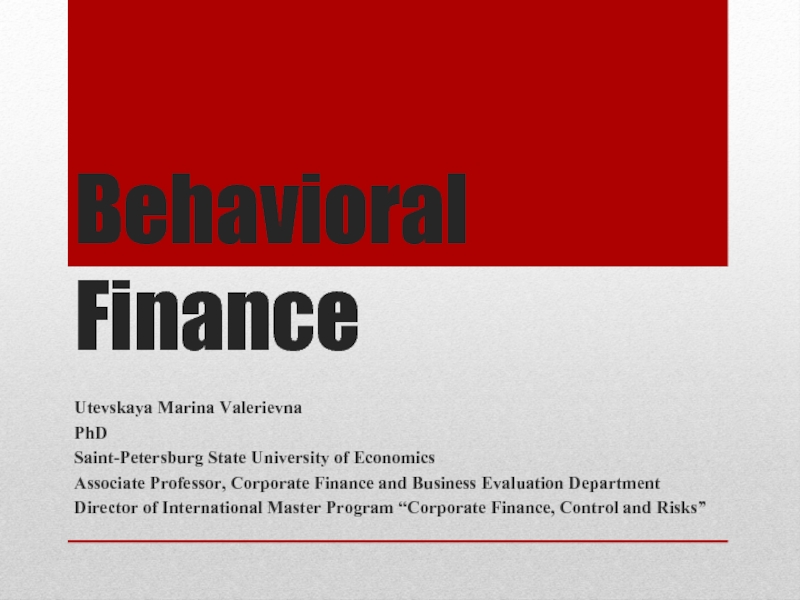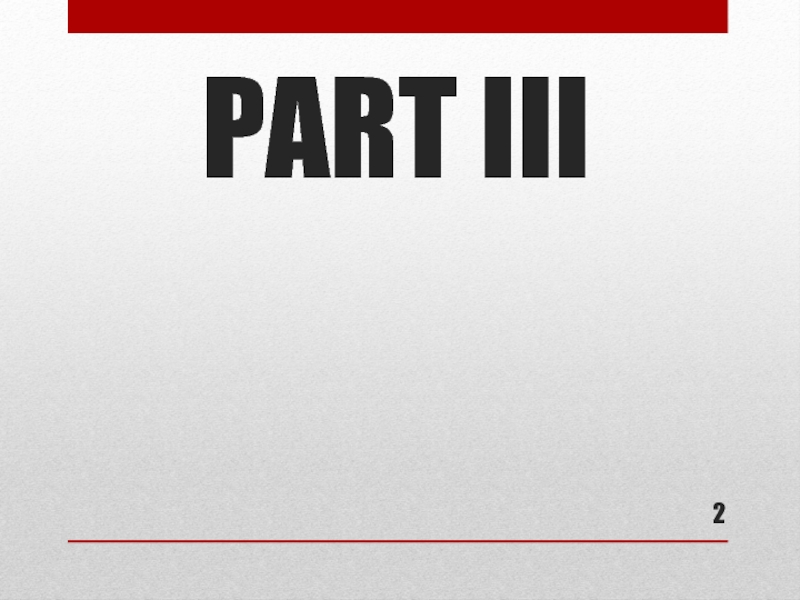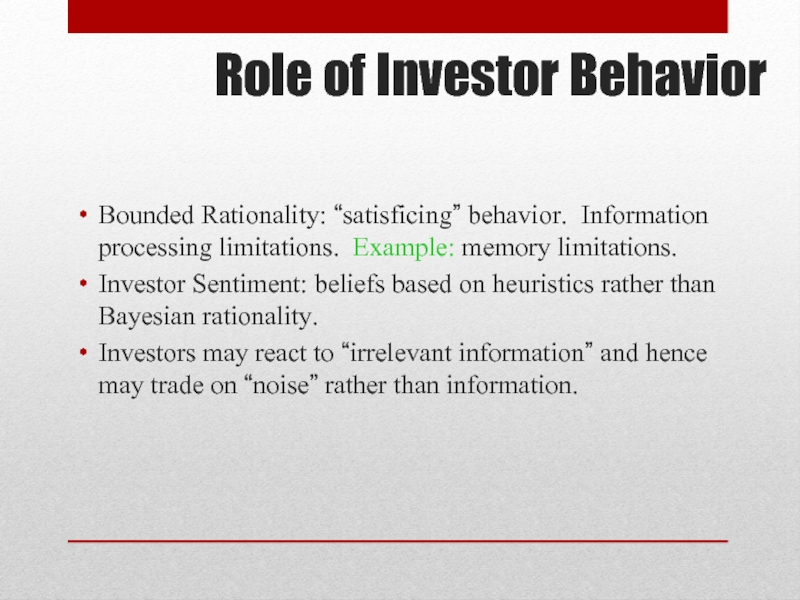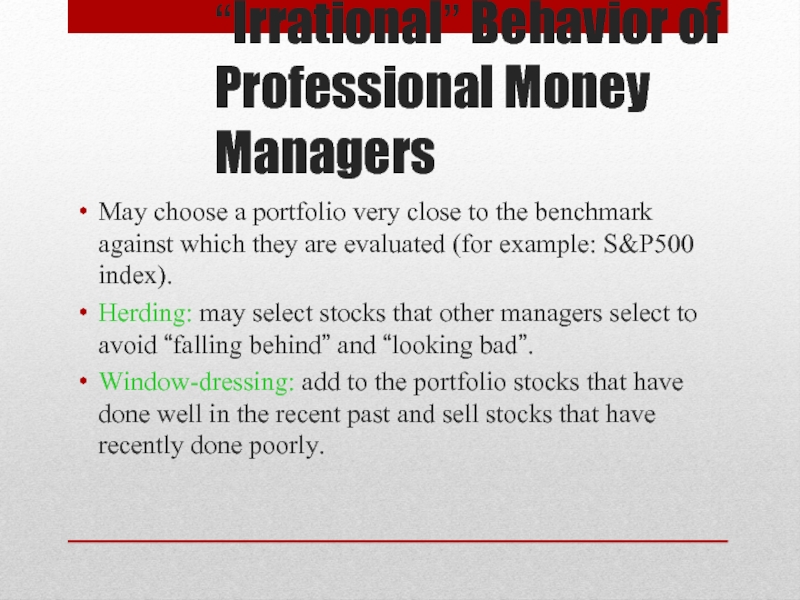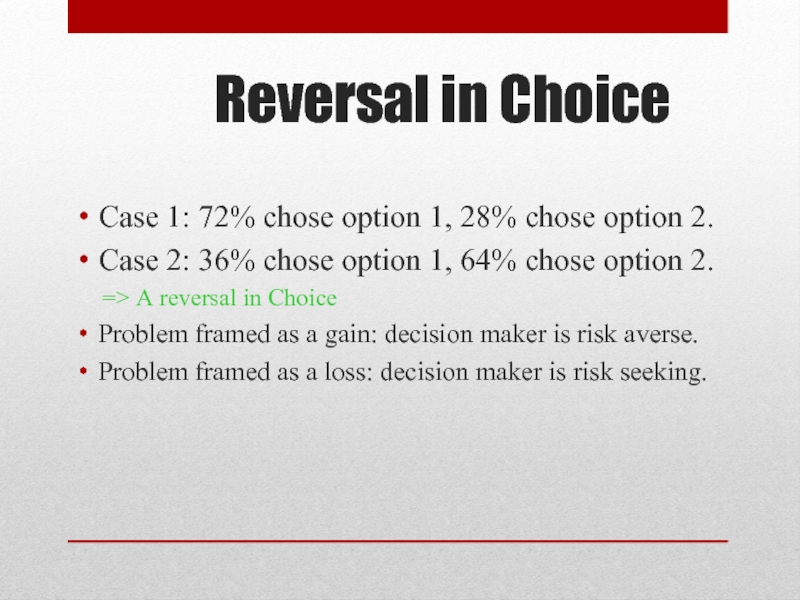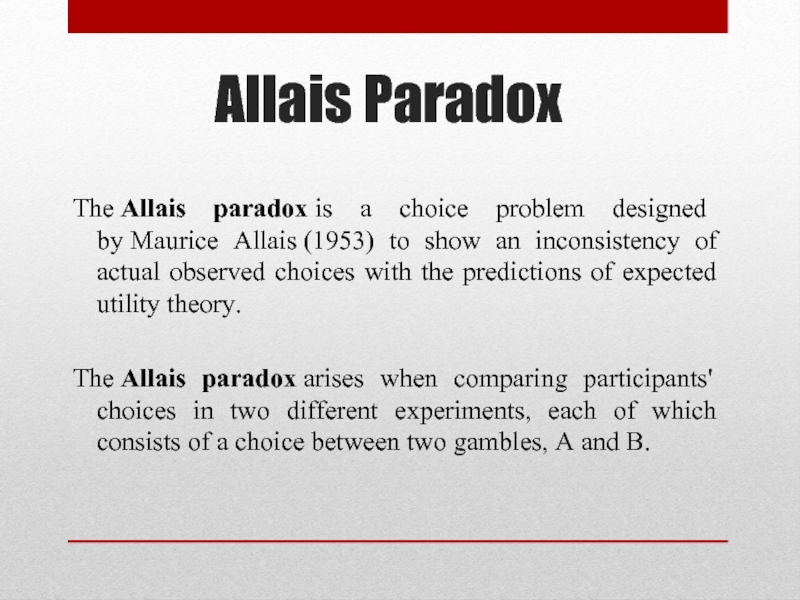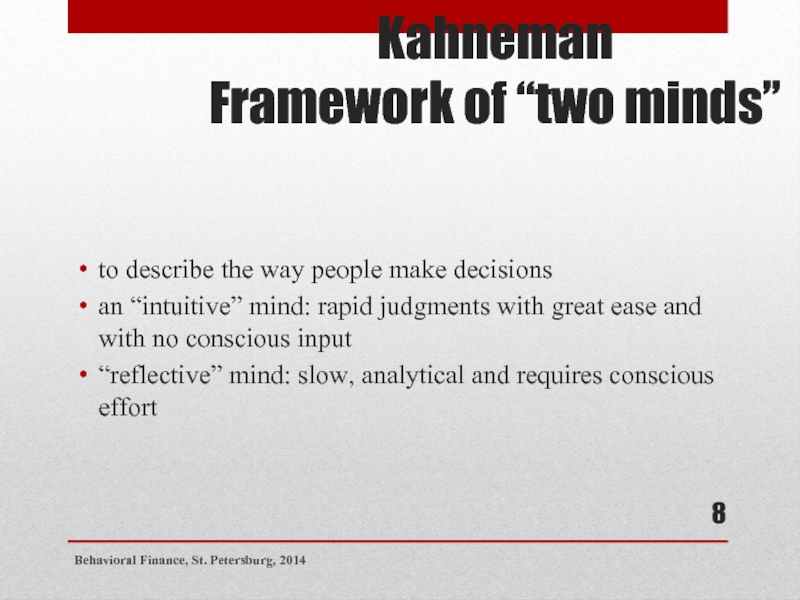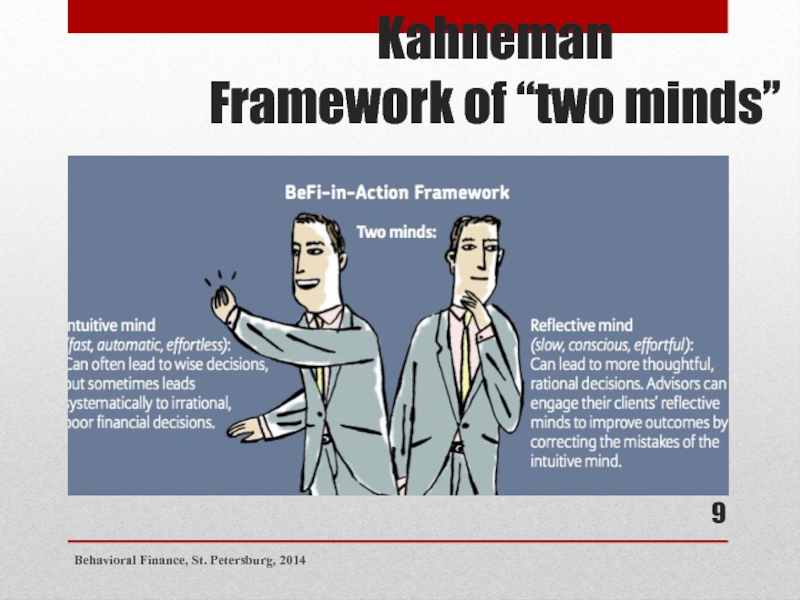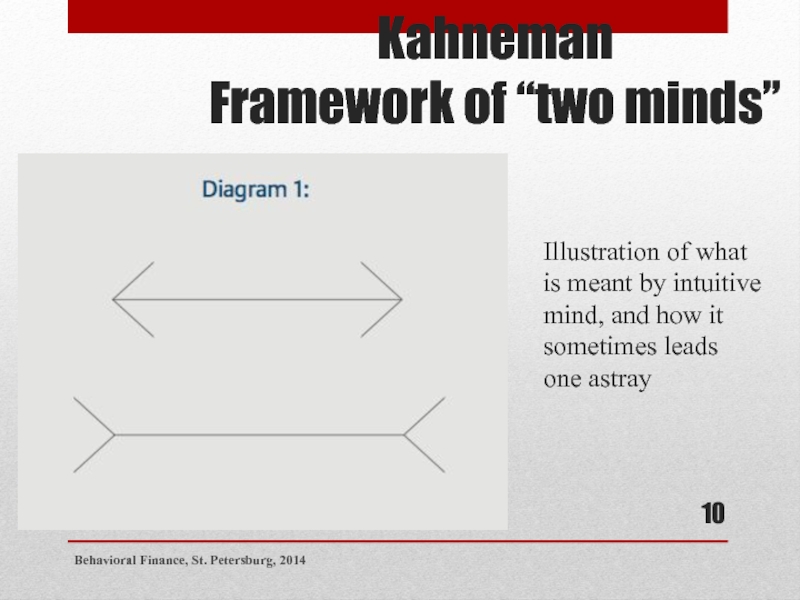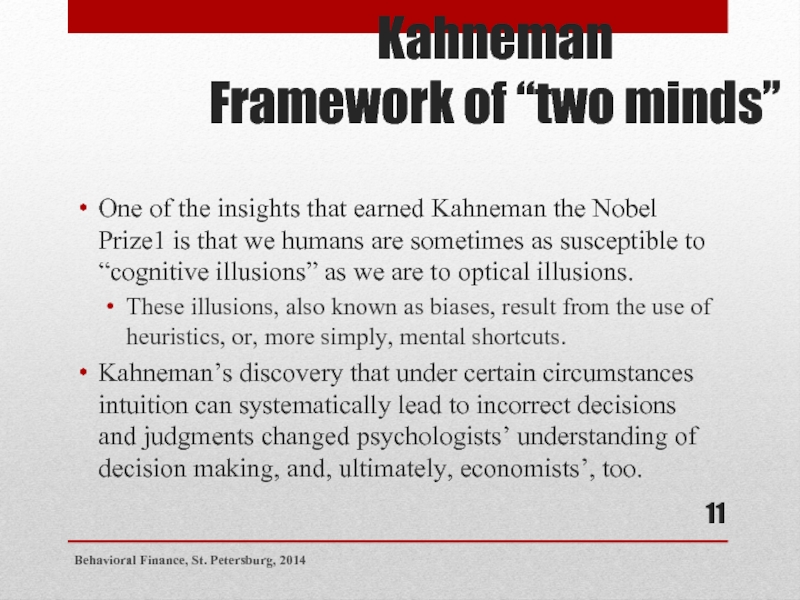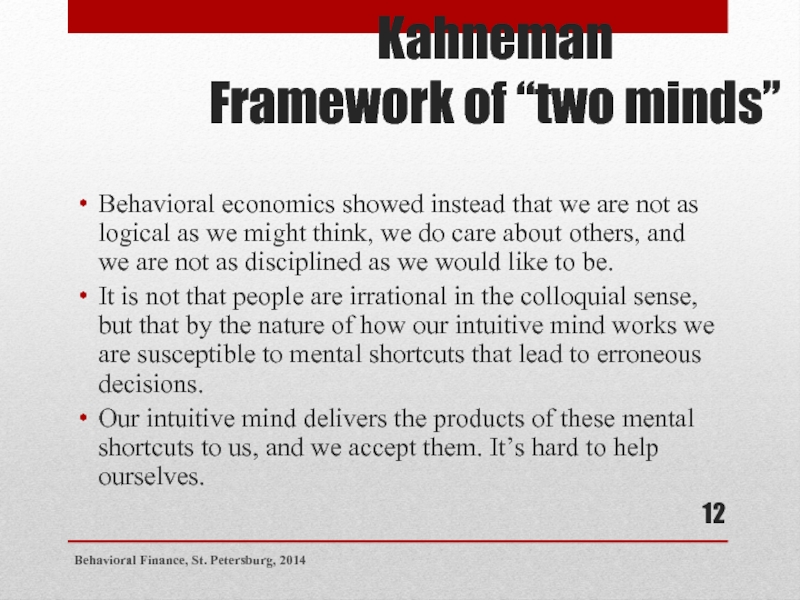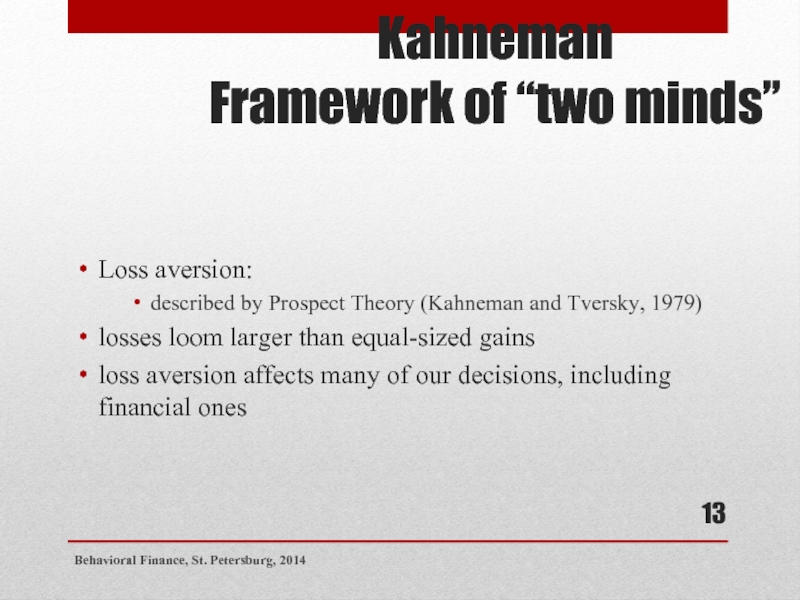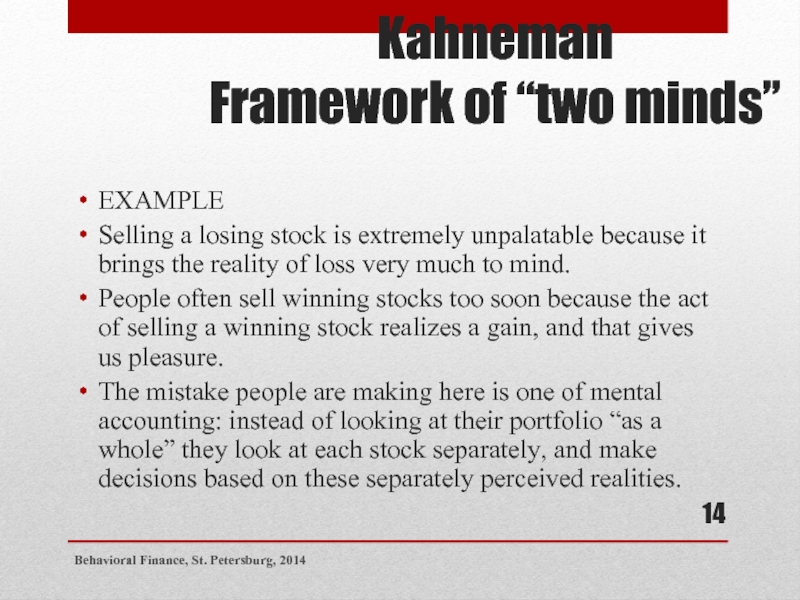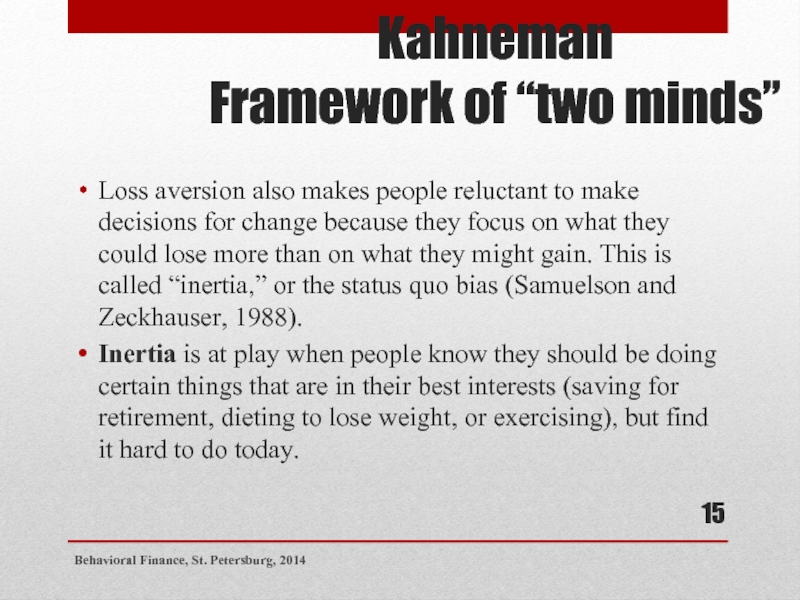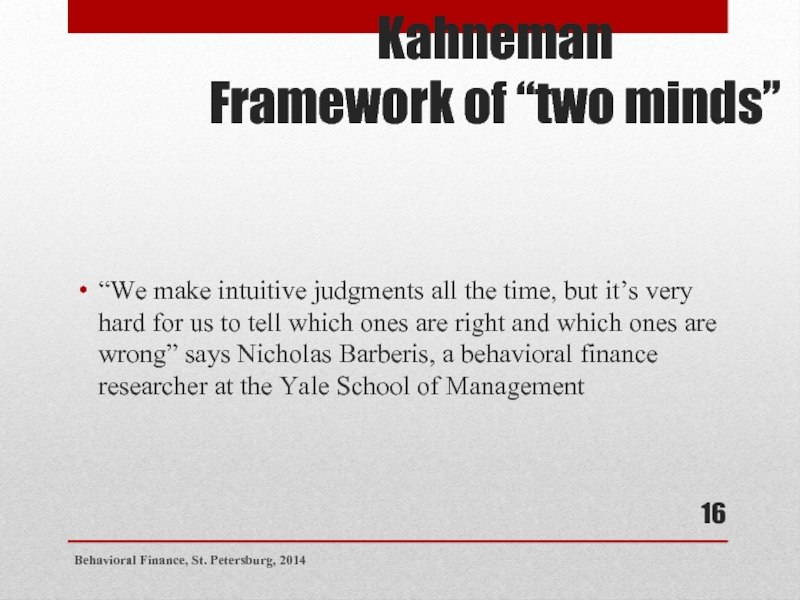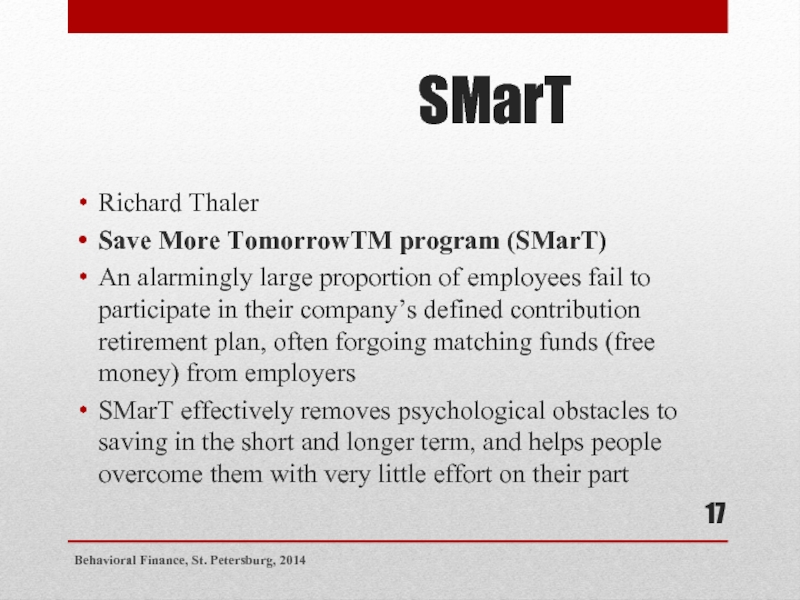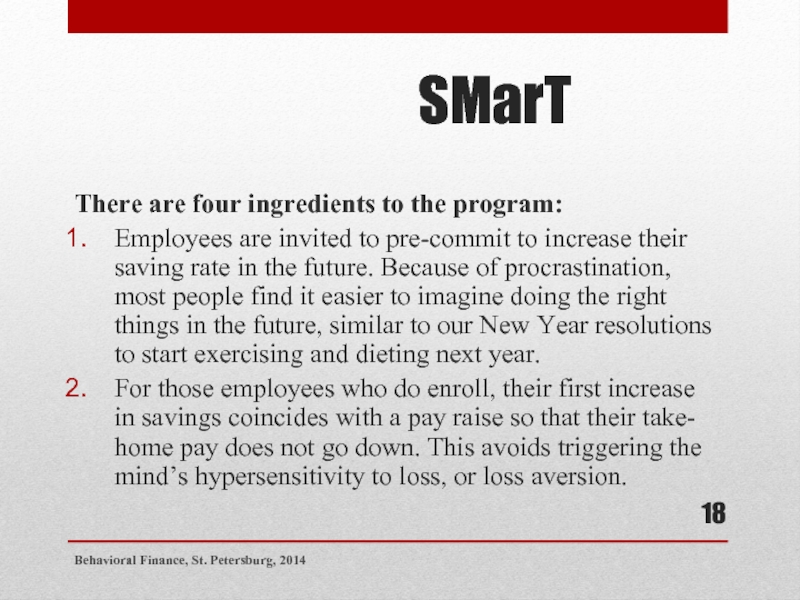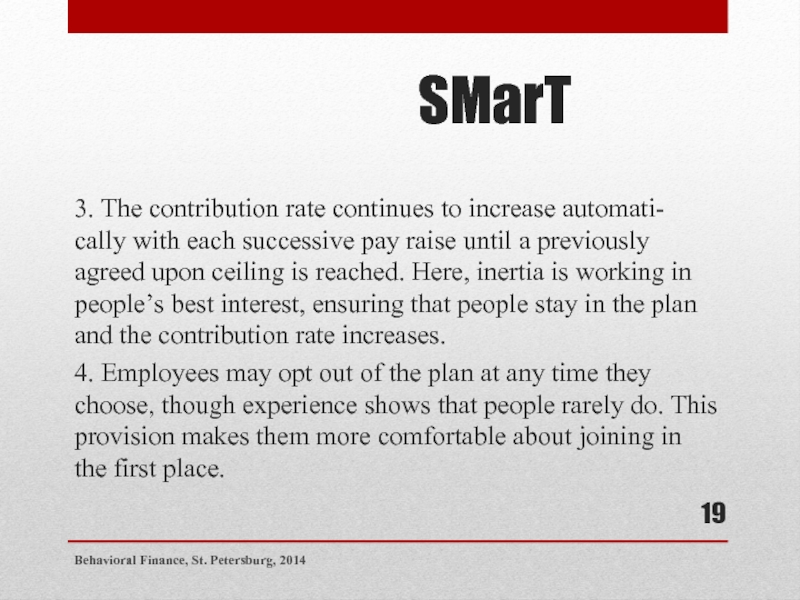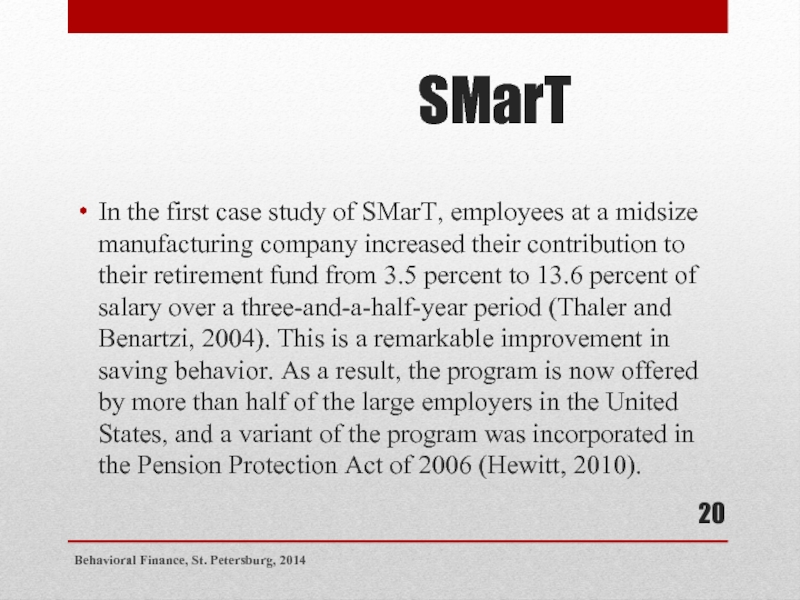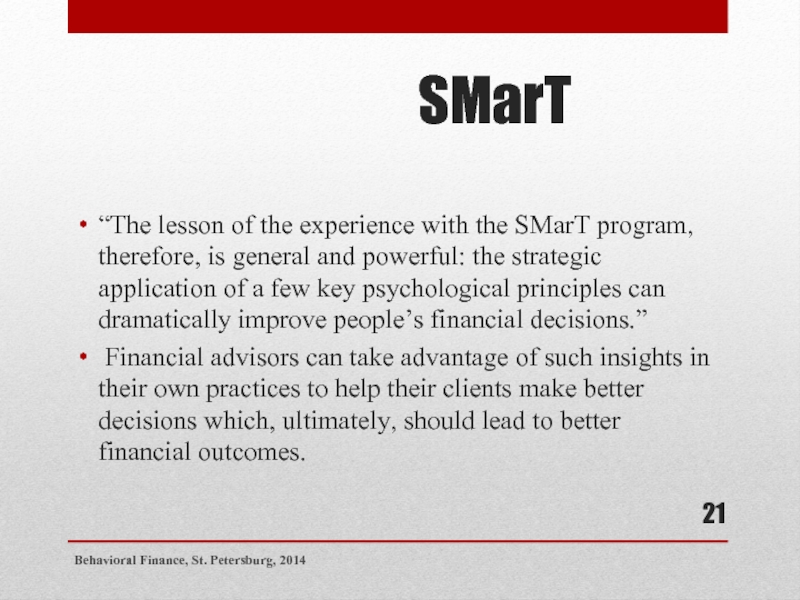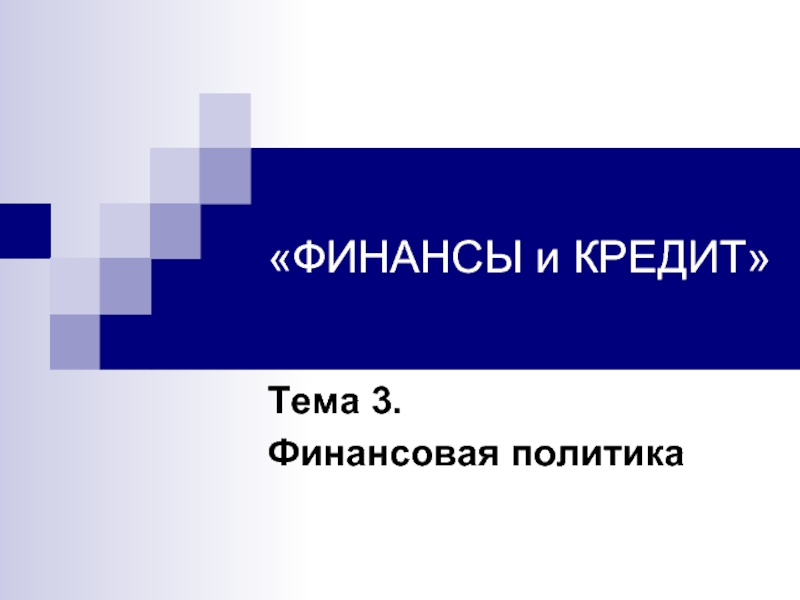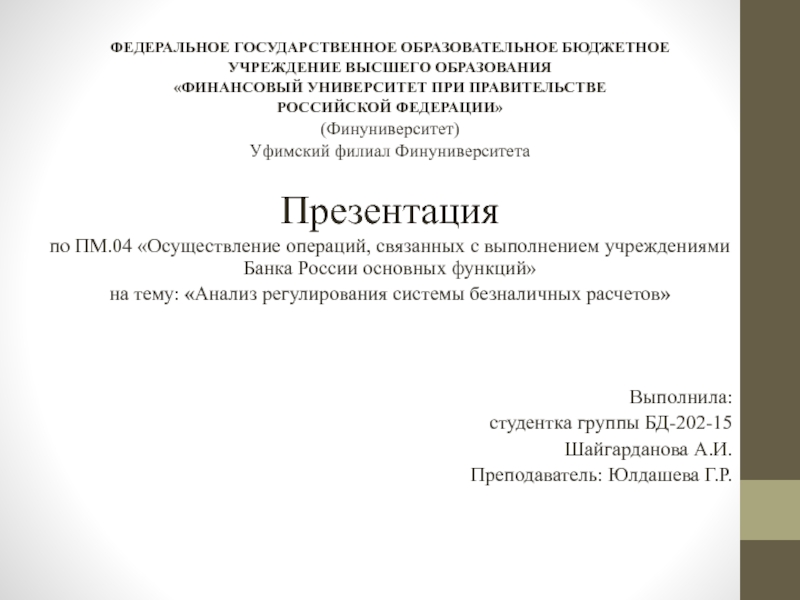- Главная
- Разное
- Дизайн
- Бизнес и предпринимательство
- Аналитика
- Образование
- Развлечения
- Красота и здоровье
- Финансы
- Государство
- Путешествия
- Спорт
- Недвижимость
- Армия
- Графика
- Культурология
- Еда и кулинария
- Лингвистика
- Английский язык
- Астрономия
- Алгебра
- Биология
- География
- Детские презентации
- Информатика
- История
- Литература
- Маркетинг
- Математика
- Медицина
- Менеджмент
- Музыка
- МХК
- Немецкий язык
- ОБЖ
- Обществознание
- Окружающий мир
- Педагогика
- Русский язык
- Технология
- Физика
- Философия
- Химия
- Шаблоны, картинки для презентаций
- Экология
- Экономика
- Юриспруденция
Behavioral finance презентация
Содержание
- 1. Behavioral finance
- 2. PART III
- 3. Role of Investor Behavior Bounded Rationality: “satisficing”
- 4. “Irrational” Behavior of Professional Money Managers May
- 5. An Example Initial endowment: $300. Consider a
- 6. Reversal in Choice Case 1: 72% chose
- 7. Allais Paradox The Allais paradox is a choice problem
- 8. Kahneman Framework of “two minds”
- 9. Kahneman Framework of “two minds” Behavioral Finance, St. Petersburg, 2014
- 10. Kahneman Framework of “two minds”
- 11. Kahneman Framework of “two minds”
- 12. Kahneman Framework of “two minds”
- 13. Kahneman Framework of “two minds”
- 14. Kahneman Framework of “two minds”
- 15. Kahneman Framework of “two minds”
- 16. Kahneman Framework of “two minds”
- 17. SMarT Richard Thaler Save More TomorrowTM
- 18. SMarT There are four ingredients to the
- 19. SMarT 3. The contribution rate continues to
- 20. SMarT In the first case study of
- 21. SMarT “The lesson of the experience with
Слайд 1Behavioral Finance
Utevskaya Marina Valerievna
PhD
Saint-Petersburg State University of Economics
Associate Professor, Corporate Finance
Director of International Master Program “Corporate Finance, Control and Risks”
Слайд 3Role of Investor Behavior
Bounded Rationality: “satisficing” behavior. Information processing limitations. Example:
Investor Sentiment: beliefs based on heuristics rather than Bayesian rationality.
Investors may react to “irrelevant information” and hence may trade on “noise” rather than information.
Слайд 4“Irrational” Behavior of Professional Money Managers
May choose a portfolio very close
Herding: may select stocks that other managers select to avoid “falling behind” and “looking bad”.
Window-dressing: add to the portfolio stocks that have done well in the recent past and sell stocks that have recently done poorly.
Слайд 5An Example
Initial endowment: $300. Consider a choice between:
a sure gain of
a 50% chance to gain $200, a 50% chance to gain $0.
Initial endowment: $500. Consider a choice between:
a sure loss of $100
a 50% chance to lose $200, a 50% chance to lose $0.
Слайд 6Reversal in Choice
Case 1: 72% chose option 1, 28% chose option
Case 2: 36% chose option 1, 64% chose option 2.
=> A reversal in Choice
Problem framed as a gain: decision maker is risk averse.
Problem framed as a loss: decision maker is risk seeking.
Слайд 7Allais Paradox
The Allais paradox is a choice problem designed by Maurice Allais (1953) to show
The Allais paradox arises when comparing participants' choices in two different experiments, each of which consists of a choice between two gambles, A and B.
Слайд 8Kahneman
Framework of “two minds”
to describe the way people make
an “intuitive” mind: rapid judgments with great ease and with no conscious input
“reflective” mind: slow, analytical and requires conscious effort
Behavioral Finance, St. Petersburg, 2014
Слайд 10Kahneman
Framework of “two minds”
Illustration of what is meant by
Behavioral Finance, St. Petersburg, 2014
Слайд 11Kahneman
Framework of “two minds”
One of the insights that earned
These illusions, also known as biases, result from the use of heuristics, or, more simply, mental shortcuts.
Kahneman’s discovery that under certain circumstances intuition can systematically lead to incorrect decisions and judgments changed psychologists’ understanding of decision making, and, ultimately, economists’, too.
Behavioral Finance, St. Petersburg, 2014
Слайд 12Kahneman
Framework of “two minds”
Behavioral economics showed instead that we
It is not that people are irrational in the colloquial sense, but that by the nature of how our intuitive mind works we are susceptible to mental shortcuts that lead to erroneous decisions.
Our intuitive mind delivers the products of these mental shortcuts to us, and we accept them. It’s hard to help ourselves.
Behavioral Finance, St. Petersburg, 2014
Слайд 13Kahneman
Framework of “two minds”
Loss aversion:
described by Prospect Theory
losses loom larger than equal-sized gains
loss aversion affects many of our decisions, including financial ones
Behavioral Finance, St. Petersburg, 2014
Слайд 14Kahneman
Framework of “two minds”
EXAMPLE
Selling a losing stock is extremely
People often sell winning stocks too soon because the act of selling a winning stock realizes a gain, and that gives us pleasure.
The mistake people are making here is one of mental accounting: instead of looking at their portfolio “as a whole” they look at each stock separately, and make decisions based on these separately perceived realities.
Behavioral Finance, St. Petersburg, 2014
Слайд 15Kahneman
Framework of “two minds”
Loss aversion also makes people reluctant
Inertia is at play when people know they should be doing certain things that are in their best interests (saving for retirement, dieting to lose weight, or exercising), but find it hard to do today.
Behavioral Finance, St. Petersburg, 2014
Слайд 16Kahneman
Framework of “two minds”
“We make intuitive judgments all the
Behavioral Finance, St. Petersburg, 2014
Слайд 17SMarT
Richard Thaler
Save More TomorrowTM program (SMarT)
An alarmingly large proportion of
SMarT effectively removes psychological obstacles to saving in the short and longer term, and helps people overcome them with very little effort on their part
Behavioral Finance, St. Petersburg, 2014
Слайд 18SMarT
There are four ingredients to the program:
Employees are invited to pre-commit
For those employees who do enroll, their first increase in savings coincides with a pay raise so that their take- home pay does not go down. This avoids triggering the mind’s hypersensitivity to loss, or loss aversion.
Behavioral Finance, St. Petersburg, 2014
Слайд 19SMarT
3. The contribution rate continues to increase automati- cally with each
4. Employees may opt out of the plan at any time they choose, though experience shows that people rarely do. This provision makes them more comfortable about joining in the first place.
Behavioral Finance, St. Petersburg, 2014
Слайд 20SMarT
In the first case study of SMarT, employees at a midsize
Behavioral Finance, St. Petersburg, 2014
Слайд 21SMarT
“The lesson of the experience with the SMarT program, therefore, is
Financial advisors can take advantage of such insights in their own practices to help their clients make better decisions which, ultimately, should lead to better financial outcomes.
Behavioral Finance, St. Petersburg, 2014
